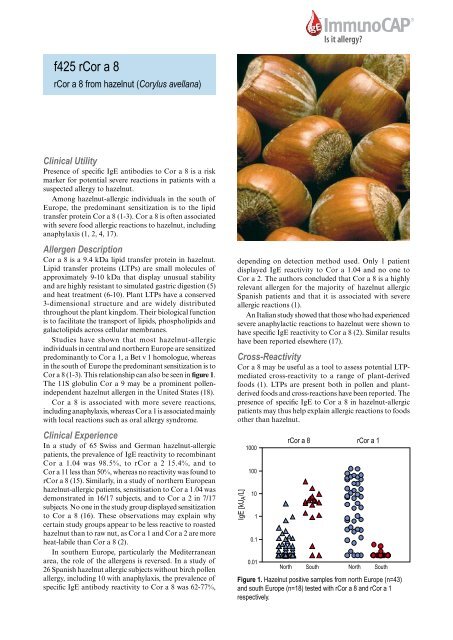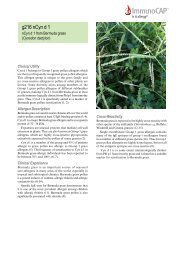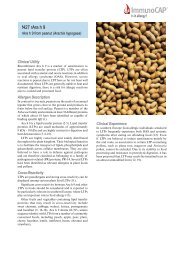You also want an ePaper? Increase the reach of your titles
YUMPU automatically turns print PDFs into web optimized ePapers that Google loves.
<strong>f425</strong> <strong>rCor</strong> a 8<br />
<strong>rCor</strong> a 8 from hazelnut (Corylus avellana)<br />
Clinical Utility<br />
Presence of specific IgE antibodies to Cor a 8 is a risk<br />
marker for potential severe reactions in patients with a<br />
suspected allergy to hazelnut.<br />
Among hazelnut-allergic individuals in the south of<br />
Europe, the predominant sensitization is to the lipid<br />
transfer protein Cor a 8 (1-3). Cor a 8 is often associated<br />
with severe food allergic reactions to hazelnut, including<br />
anaphylaxis (1, 2, 4, 17).<br />
Allergen Description<br />
Cor a 8 is a 9.4 kDa lipid transfer protein in hazelnut.<br />
Lipid transfer proteins (LTPs) are small molecules of<br />
approximately 9-10 kDa that display unusual stability<br />
and are highly resistant to simulated gastric digestion (5)<br />
and heat treatment (6-10). Plant LTPs have a conserved<br />
3-dimensional structure and are widely distributed<br />
throughout the plant kingdom. Their biological function<br />
is to facilitate the transport of lipids, phospholipids and<br />
galactolipids across cellular membranes.<br />
Studies have shown that most hazelnut-allergic<br />
individuals in central and northern Europe are sensitized<br />
predominantly to Cor a 1, a Bet v 1 homologue, whereas<br />
in the south of Europe the predominant sensitization is to<br />
Cor a 8 (1-3). This relationship can also be seen in figure 1.<br />
The 11S globulin Cor a 9 may be a prominent pollenindependent<br />
hazelnut allergen in the United States (18).<br />
Cor a 8 is associated with more severe reactions,<br />
including anaphylaxis, whereas Cor a 1 is associated mainly<br />
with local reactions such as oral allergy syndrome.<br />
Clinical Experience<br />
In a study of 65 Swiss and German hazelnut-allergic<br />
patients, the prevalence of IgE reactivity to recombinant<br />
Cor a 1.04 was 98.5%, to <strong>rCor</strong> a 2 15.4%, and to<br />
Cor a 11 less than 50%, whereas no reactivity was found to<br />
<strong>rCor</strong> a 8 (15). Similarly, in a study of northern European<br />
hazelnut-allergic patients, sensitisation to Cor a 1.04 was<br />
demonstrated in 16/17 subjects, and to Cor a 2 in 7/17<br />
subjects. No one in the study group displayed sensitization<br />
to Cor a 8 (16). These observations may explain why<br />
certain study groups appear to be less reactive to roasted<br />
hazelnut than to raw nut, as Cor a 1 and Cor a 2 are more<br />
heat-labile than Cor a 8 (2).<br />
In southern Europe, particularly the Mediterranean<br />
area, the role of the allergens is reversed. In a study of<br />
26 Spanish hazelnut allergic subjects without birch pollen<br />
allergy, including 10 with anaphylaxis, the prevalence of<br />
specific IgE antibody reactivity to Cor a 8 was 62-77%,<br />
depending on detection method used. Only 1 patient<br />
displayed IgE reactivity to Cor a 1.04 and no one to<br />
Cor a 2. The authors concluded that Cor a 8 is a highly<br />
relevant allergen for the majority of hazelnut allergic<br />
Spanish patients and that it is associated with severe<br />
allergic reactions (1).<br />
An Italian study showed that those who had experienced<br />
severe anaphylactic reactions to hazelnut were shown to<br />
have specific IgE reactivity to Cor a 8 (2). Similar results<br />
have been reported elsewhere (17).<br />
Cross-Reactivity<br />
Cor a 8 may be useful as a tool to assess potential LTPmediated<br />
cross-reactivity to a range of plant-derived<br />
foods (1). LTPs are present both in pollen and plantderived<br />
foods and cross-reactions have been reported. The<br />
presence of specific IgE to Cor a 8 in hazelnut-allergic<br />
patients may thus help explain allergic reactions to foods<br />
other than hazelnut.<br />
IgE [kU /L]<br />
A<br />
1000<br />
100<br />
10<br />
1<br />
0.1<br />
0.01<br />
<strong>rCor</strong> a 8<br />
<strong>rCor</strong> a 1<br />
North South North South<br />
Figure 1. Hazelnut positive samples from north Europe (n=43)<br />
and south Europe (n=18) tested with <strong>rCor</strong> a 8 and <strong>rCor</strong> a 1<br />
respectively.
References<br />
1. Schocker F, LuttkopF D, Scheurer S, peterSen A, ciStero-BAhimA A,<br />
enrique e, SAn migueL-moncin m, AkkerDAAS J, vAn ree r,<br />
viethS S, Becker Wm.<br />
Recombinant lipid transfer protein Cor a 8 from<br />
hazelnut: a new tool for in vitro diagnosis of<br />
potentially severe hazelnut allergy.<br />
J Allergy Clin Immunol 2004;113(1):141-7.<br />
2. pAStoreLLo eA, viethS S, prAvettoni v, FArioLi L, trAmBAioLi c,<br />
FortunAto D, LuttkopF D, cALAmAri m, AnSALoni r, SciBiLiA J,<br />
BALLmer-WeBer Bk, pouLSen Lk, Wutrich B, hAnSen kS,<br />
roBino Am, ortoLAni c, conti A.<br />
Identification of hazelnut major allergens in sensitive<br />
patients with positive double-blind, placebo-controlled<br />
food challenge results.<br />
J Allergy Clin Immunol 2002;109(3):563-70.<br />
3. AnDerSSon k, BALLmer-WeBer Bk, ciStero-BAhimA A, oStLing J,<br />
LAuer i, viethS S, LiDhoLm J.<br />
Enhancement of hazelnut extract for IgE testing by<br />
recombinant allergen spiking.<br />
Allergy 2007;62(8):897-904.<br />
4. Scheurer S, pAStoreLLo eA, WAngorSch A, kAStner m, hAuStein D,<br />
viethS S.<br />
Recombinant allergens Pru av 1 and Pru av 4 and a<br />
newly identified lipid transfer protein in the in vitro<br />
diagnosis of cherry allergy.<br />
J Allergy Clin Immunol 2001;107(4):724-31.<br />
5. ASero r, miStreLLo g, roncAroLo D, AmAto S, cALDironi g,<br />
BArocci F, vAn ree r.<br />
Immunological cross-reactivity between lipid transfer<br />
proteins from botanically unrelated plant-derived<br />
foods: a clinical study.<br />
Allergy 2002;57(10):900-6.<br />
6. ASero r, miStreLLo g, roncAroLo D, AmAto S.<br />
Relationship between peach lipid transfer protein<br />
specific IgE levels and hypersensitivity to non-<br />
Rosaceae vegetable foods in patients allergic to lipid<br />
transfer protein.<br />
Ann Allergy Asthma Immunol 2004;92(2):268-72.<br />
7. ASero r, miStreLLo g, roncAroLo D, AmAto S, FALAgiAni p.<br />
Analysis of the heat stability of lipid transfer protein<br />
from apple. [Letter]<br />
J Allergy Clin Immunol 2003;112(5):1009-11<br />
8. pAStoreLLo eA, pompei c, prAvettoni v, FArioLi L, cALAmAri Am,<br />
SciBiLiA J, roBino Am, conti A, iAmetti S, FortunAto D, Bonomi S,<br />
ortoLAni c.<br />
Lipid-transfer protein is the major maize allergen<br />
maintaining IgE-binding activity after cooking at 100<br />
degrees C, as demonstrated in anaphylactic patients<br />
and patients with positive double-blind, placebocontrolled<br />
food challenge results.<br />
J Allergy Clin Immunol 2003;112(4):775-83.<br />
9. ASero r, AmAto S, ALFieri B, FoLLoni S, miStreLLo g. rice.<br />
Another potential cause of food allergy in patients<br />
sensitized to lipid transfer protein.<br />
Int Arch Allergy Immunol 2006 Dec 28;143(1):69-74.<br />
10. Scheurer S, LAuer i, FoetiSch k, moncin mS, retzek m, hArtz c,<br />
enrique e, LiDhoLm J, ciStero-BAhimA A, viethS S.<br />
Strong allergenicity of Pru av 3, the lipid transfer<br />
protein from cherry, is related to high stability against<br />
thermal processing and digestion.<br />
J Allergy Clin Immunol 2004;114(4):900-7.<br />
11. De groot h, De Jong nW, vuiJk mh, gerth vAn WiJk r.<br />
Birch pollinosis and atopy caused by apple, peach, and<br />
hazelnut; comparison of three extraction procedures<br />
with two apple strains.<br />
Allergy 1996;51(10):712-8.<br />
12. moLkhou p.<br />
The problems of the child with food allergies. [French]<br />
Allerg Immunol (Paris) 2003;35(1):7-8.<br />
13. tAriq Sm, StevenS m, mAttheWS S, riDout S, tWiSeLton r, hiDe DW.<br />
Cohort study of peanut and tree nut sensitisation by<br />
age of 4 years.<br />
BMJ 1996;313(7056):514-7.<br />
14. SALceDo g, Sánchez-monge r, BArBer D, DíAz-perALeS A.<br />
Plant non-specific lipid transfer proteins: an interface<br />
between plant defence and human allergy.<br />
Biochim Biophys Acta 2007;1771(6):781-91.<br />
15. AkkerDAAS Jh, Schocker F, viethS S, verSteeg S, zuiDmeer L,<br />
heFLe SL, AALBerSe rc, richter k, FerreirA F, vAn ree r.<br />
Cloning of oleosin, a putative new hazelnut allergen,<br />
using a hazelnut cDNA library.<br />
Mol Nutr Food Res 2005;50(1):18-23.<br />
16. hAnSen kS, BALLmer-WeBer Bk, LuttkopF D, Skov pS, Wuthrich B,<br />
BinDSLev-JenSen c, viethS S, pouLSen Lk.<br />
Roasted hazelnuts – allergenic activity evaluated by<br />
double-blind, placebo-controlled food challenge.<br />
Allergy 2003;58(2):132-8.<br />
17. Schocker F, LuttkopF D, muLLer u, thomAS p, viethS S, Becker Wm.<br />
IgE binding to unique hazelnut allergens: identification<br />
of non pollen-related and heat-stable hazelnut<br />
allergens eliciting severe allergic reactions.<br />
Eur J Nutr 2000;39(4):172-80.<br />
18. Beyer k, griShinA g, BArDinA L, griShin A, SAmpSon hA.<br />
Identification of an 11S globulin as a major hazelnut<br />
food allergen in hazelnut-induced systemic reactions.<br />
J Allergy Clin Immunol 2002;110:517-23.<br />
For further reading, see: www.immunocapinvitrosight.com<br />
Phadia AB. P O Box 6460, SE-751 37 Uppsala, Sweden<br />
Tel +46 18 16 50 00. www.phadia.com April 2009, November 2009




